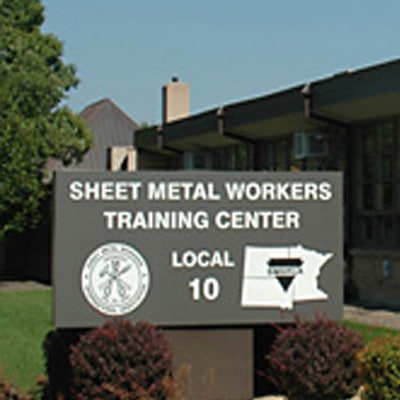
“Green” can be a buzzword, or it can be a way of life and doing business. Sheet Metal Workers Local No. 10 in White Bear Lake, Minnesota and Local No. 20 in Indianapolis are two examples of schools that are not only incorporating green initiatives into their work, but they are teaching sheet metal workers of the future how to incorporate it into their industry.
Energy efficiency in Indiana’s five training centers began with the Indianapolis school, which sunk its energy bills by sinking four coil cribs in a nearby pond to use water as an energy source to heat and cool the training center using geothermal equipment. Since the fall of 2012, four coils have been placed in the pond. This summer the three remaining heating/cooling systems will be replaced when coils are buried in the earth, which stays at around 55 degrees, using another form of green energy.
In both cases, instead of using air to either cool coils or pull heat out of the air, the systems are using the water or ground temperature to do the work, said Tim Myres, training director in Indianapolis.
“Our utility bills have dropped significantly,” Myres said. Compared to the last two years, April’s electric bill was 25 percent less, and the natural gas bill has been reduced to nearly nothing. All the hot water in the building is produced by geothermal systems as well.
“As utility prices go up, people are looking for a way to heat and cool their facilities. In Indiana, there has been increased interest in geothermal. People’s utility bills are high no matter what time of the year it is. Here, it’s 100 degrees in the summer and -10 degrees in the winter.”
The renovation to the center’s heating and cooling system provided training opportunities for the apprentices, who are working for contractors who work to meet consumer demand to help lower utility bills.
“Everything we’ve installed we’ve installed as a teaching module. As we teach geothermal theory, or installation or service, they can practice on the training center’s systems,” Myres added. “We’ve had a lot of requests in the last year or so for green energy training from members and contractors. And there is a big push on service training in Local No. 20. This goes hand-in-hand with that, also.”
At Local No. 10 in Minnesota, the membership encourages and entices apprentices and journeymen to study for and pass the Leadership in Energy and Environmental Design (LEED) Green Associate exam with a reimbursement and bonus program. The training center will reimburse the apprentice or journeymen the $250 exam fee, and – if they pass – a $150 bonus. To date, 20 members have been credentialed.
Apprentices who achieve the credential also are credited with 40 bonus school hours to use as a substitute for any of their regularly school time. Studying for the exam takes at least 40 hours, so giving those hours back when they pass adds flexibility the apprentices appreciate, said Buck Paulsrud, training director for Local No. 10.
“You have to know the material and be pretty well-rounded. In today’s construction world, the white hats, the ones who manage the job site – an awful lot of those people are LEED credentialed, and we’re driving that level of expertise to the boots on the ground,” Paulsrud said. “If we use the wrong products, or if we park on a part of the site that can’t be disturbed, that loses (LEED) points for the project that can’t be regained. Anybody on the site can screw up these points. Once they’re gone, they’re gone.”
Employers seek apprentices and journeymen who are LEED credentialed order to offer the expertise to entice projects.
“The individuals who have earned their credential have gained new employment or bettered themselves with their employer. The people who get this tend to do very well,” Paulsrud said. “The first apprentice who earned this was unemployed. After he earned the credential, he got hired right away. The employer reached down past all the other out-of-work apprentices in front of him and grabbed him because they wanted this expertise in the field.”
Recent green projects include the future new Vikings football stadium and the recently completed Target Field and TCF Bank Stadium.
“Even projects that aren’t LEED-certified are still built to LEED standards,” Paulsrud added. Utility bills are always a concern in regards to a business’ bottom line. “Some entities are choosing to follow all the rules to getting a greener building but don’t necessarily go for the certification.”
Related News
- Statement from National Safety & Legislative Director Jared Cassity on FRA’s ATI Ruling
- Long-time Union Ally Mikie Sherrill Runs for New Jersey Governor
- New law would end unfair taxation on workers’ strike pay
- 1% Declares War On 2-PC & SMART-TD
- NRLC Bargaining Chart
- Local Pride T-Shirt Contest Rules
- Local 9 Car Show – Car Registration
- Public Comment of SMART-TD Regarding Tesla’s Special Permit Request for Transporting Lithium Batteries by Rail
- Colorado Transit Worker Safety Bill (House Bill 25-1290)
- Assembly, No. 1672